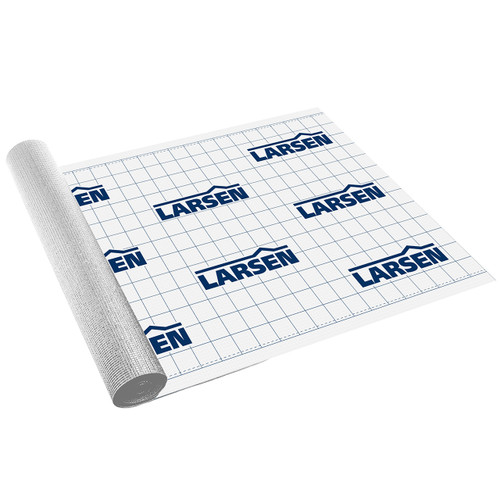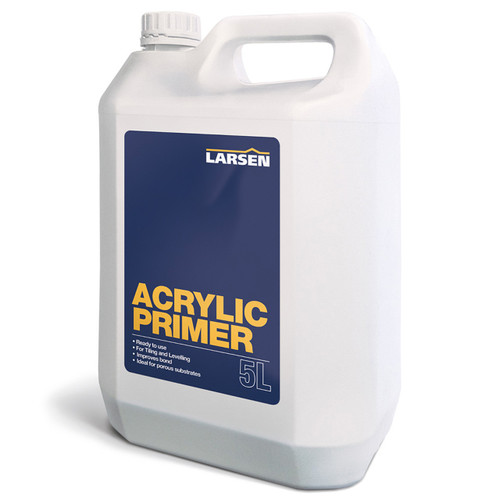
Larsen FiberFlex Semi-Rapid Set Adhesive - WHITE - S1 - 20kg
Larsen FiberFlex Semi-Rapid Set Adhesive - WHITE - S1 - 20kg
Professional Fiberflex Semi-Rapid Set+ is a fully flexible, S1-rated, microfibre reinforced, non-slip, cement-based adhesive.
Larsen FiberFlex Semi-Rapid Set+ is a specially formulated, fully flexible, S1 rated, microfibre reinforced, non-slip, cement-based adhesive. It is suitable for large format panels, porcelain, ceramic, and natural stone tiles.
It is suitable for beds of 3-20mm, interior, exterior, floor, and wall applications.
- Set Time: 6 hours
- Pot Life: 2 hours
- Soft, easy to use thixotropic adhesive
Coverage:
4 sq./m / 20kg bag @ 3mm bed
Professional Fiberflex™ Semi-Rapid Set+ is a fully flexible, S1-rated, microfibre reinforced, non-slip, cement-based adhesive. The specially formulated semi-rapid setting binder has been developed to provide a long pot life and open time but with subsequent rapid strength development.
This is coupled with advanced GEL Technology which gives a soft, easy to use thixotropic adhesive ideal for use with modern large format tiles. It is recommended for use in more demanding areas including with very large format tiles and externally.
DIRECTIONS FOR USE
PREPARATION
All substrates must be suitably dry and comply with the recommendations in the British Standards and TTA Guidance documents. All substrates should be clean and thoroughly sound; they should be free from standing water, oils, grease, dust, loose particles or any other contaminants which may interfere with adhesion.
Gypsum Based Screeds
Gypsum based screeds require mechanical preparation by buffing, vacuuming etc. If an underfloor heating system is present, it must have been fully commissioned up to temperature and the screed must be tested to ensure it is dry (less than 0.5% moisture content measured by CM). All gypsum-based screeds should be primed as follows: first coat Acrylic Primer diluted 1:1 with water and allowed to dry; second coat Acrylic Primer applied net and allowed to dry fully.
Gypsum Plaster
Gypsum plaster on walls is suitable for a weight of tiles and adhesive of up to 20 kg/m2.
Plaster should not be dusty or overly polished and should be primed with Larsen Acrylic Primer.
Underfloor Heating
New heating systems must have been trialled at a high temperature for a period of at least 48 hours in advance of tiling. Ensure the heating is turned off at least 48 hours before any tiling work is carried out and not turned on until at least 7 days after the work has been completed. Heating should be turned on at the lowest setting and the temperature increased by no more than 5˚C per 24 hours. Particular attention should be given to ensure there is adequate provision for movement joints in the tiling.
Timber Substrates
There have been changes to recommended guidance on tiling onto timber substrates, for example, timber sheet materials on walls are no longer accepted as a suitable substrate for tiling. Please consult current standards, recommendations and TTA advice before tiling onto timber.
Timber substrates must be sufficiently rigid and supported to be free from excessive deflection under expected loads. Ensure adequate ventilation exists beneath the floor. Ensure all new wood (including joists) is ‘dry’ and conditioned.
The floor should be designed to accommodate both seasonal changes in moisture and the changes caused by step changes in heating. Extra joists/noggins should be added to strengthen the floor as required.
In wet areas timber substrates must be suitably tanked. On floors, existing floorboards should be overboarded.
Plywood used for overboarding must be at least 15mm thick exterior grade.
Boards should be free from any wax or other coating which may impair bond. Ensure surface is free from contamination and that the backs and edges of all boards are sealed against moisture ingress. Boards should be laid broken-bonded with the long edges running at right angles to the joints between the existing boards and screwed to joists and existing boards at 300 mm centres.
Movement Joints
It is important to ensure that there is adequate provision of movement joints in all wall and floor tiling. It is recommended to follow the guidance provided in BS5385, by the TTA and by proprietary joint manufacturers. Ideally, movement joints should be detailed by the designer at the outset. As a guide in external applications max bay size should be 10 m2; internally with underfloor heating, max bay size should be less than 40 m2 and internally on stable substrates without underfloor heating, maximum bay size should be less than 100 m2. All joints in the substrate should also be carried through the tiling. For further information or for situations which are not covered above, consult our website or contact our Technical Dept.
PRIMING
Larsen Acrylic Primer should be used on all gypsum substrates and as required on other porous substrates. On more difficult substrates, Larsen Primer Grip 360 should be used.
MIXING
The adhesive should be added to clean water and mixed with a suitable slow speed drill and paddle until a lump free mortar is produced.
The water ratio can be adjusted depending on the application. For non-slip application on walls, mix 20 kg with approx. 5 L water. For full wettability and bedding on floors, mix 20 kg with up to 6 L water. The amount of water to be added, is an approximate guide. It is possible to obtain mixtures of variable consistency depend on the application. The mixed adhesive is usable for up to 2 hours depending on site temperature and conditions. Do not attempt to remix adhesive or add extra water after it has begun to stiffen as this will cause a loss in performance.
APPLICATION
The mixed adhesive should be applied to dry areas on walls using a suitable notched trowel and applied by solid bed on wet areas on walls, on all exterior tiling and on all floor tiling. It is recommended that trowelling is carried out in straight lines rather than ‘swirls’. In addition, when fitting very large format tiles, it is highly recommended to also fully skim the back of the tile with a thin layer of adhesive.
Tiles should be placed with a firm twisting action before the adhesive has skinned over, i.e. within the open time of up to 30 min. Regularly check to ensure adequate contact between adhesive, tile and substrate. ‘Dot and Dab’ method of fixing is never acceptable.
GROUTING
Only grout when the tile adhesive has set. Typically this is within 6 hours.
RESTRICTIONS
‘Dot and Dab’ method of fixing is not suitable. Tiles should not be fixed to wooden substrates externally or in wet areas. Excessive deflection/movement resulting from incorrect preparation will result in cracking of tiles and/or debonding. Floating Timber and Laminate floors are not recommended substrates for direct fixing of rigid floor finishes. Pale coloured marble/porcelain can be translucent and dark coloured adhesive can sometimes show through. If in doubt we would always recommend tiling a small trial area using a white adhesive and back buttering the tiles to ensure a uniform adhesive coverage. Cement-based products will take longer to harden and set at lower temperatures, and should not be used below 5°C. All tiling should be carried to current best practice, including British Standards and TTA Guidance documents.





